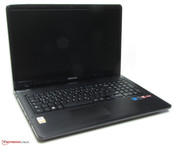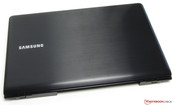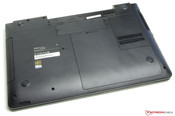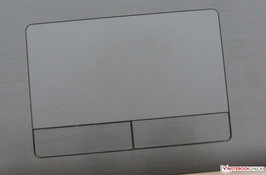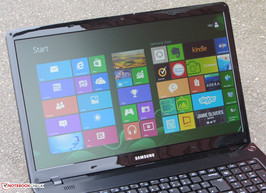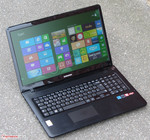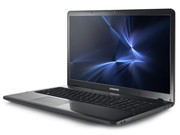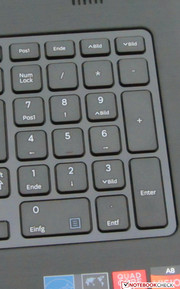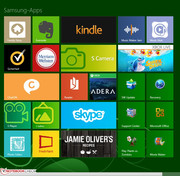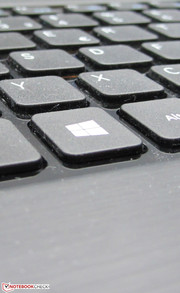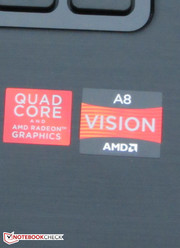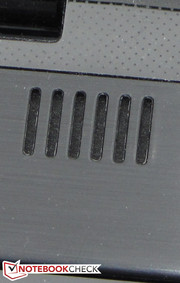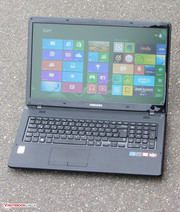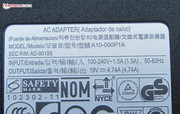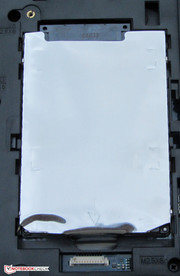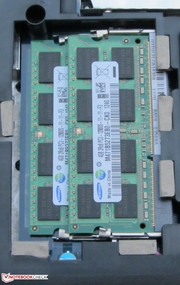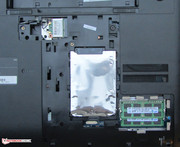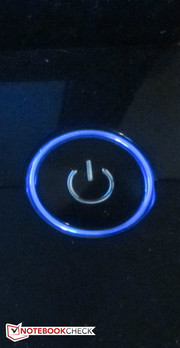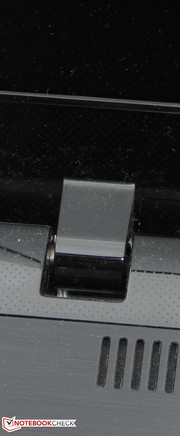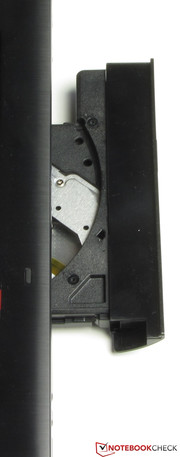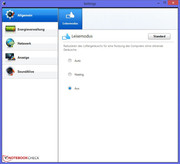Review Samsung Series 3 355E7C-S05DE Notebook

For the original German review, see here.
According to Samsung's website, the 355E7C is supposed to be a user-friendly family laptop. This evaluation seems plausible on paper. The matte screen allows working in the office, the dual-graphics solution enables playing up-to-date 3D games and, owing to a 750 GB hard drive, there is a lot of storage capacity available. Our test shows whether Samsung's laptop can fulfill the promise made on paper.
We used Toshiba's Satellite L875D-10E (AMD A8-4500M, AMD Radeon HD 7640G + HD 7610M dual-graphics) and Packard Bell's EasyNote LV44HC-137GE (Core i5-3210M, Nvidia GeForce GT 630M) to classify the laptop.
Case
The entire casing is black and Samsung completely relies on plastic. The base unit's top and the lid's back feature matte, brushed metal looks. The illusion of a metal surface is implemented very successfully. The display's frame and the keyboard's bezel are made of a glossy plastic and make fingerprints unavoidable. Packard Bell's laptop is also completely made of plastic. Toshiba uses aluminum components besides plastic in its Satellite.
The base unit is not the most stable. It dents when pressure is applied to the area underneath the touchpad and on the keyboard's left. Also, the base unit's front right corner lifts from the surface when the frame on the keyboard's left is pushed down. The base unit's stiffness could also be better. The same is true for the lid. Its back can be pressed to such an extent that minor picture distortions are seen. The hinges keep the lid firmly in place but rock a bit. It is not possible to open the lid with one hand.
Connectivity
The connectivity of our three comparison models is virtually identical. All three laptops feature today's standard interfaces. Every laptop comes with two USB 3.0 ports. The interface positioning on Samsung's laptop is not compelling. They are mostly in the front of both sides.
Communication
Cabled networks are connected via Realtek's RTL8168/8111 Gigabit Ethernet chip. Atheros' AR9485WB-EG chip is installed for Wi-Fi standard 802.11 b/g/n. The reception is very good. Windows' Wi-Fi indicator displayed full deflection both in the router's immediate vicinity (approx. 3 meters) as well as two floors below it. Samsung relies on an Atheros AR3012 chip for Bluetooth 4.0. The installed 1.3 megapixel webcam shoots pale and noisy pictures with a resolution of up to 1280x1024.
Accessories
The usual brochures are included: A warranty information leaflet, a quick start poster and a brief manual about Samsung's preinstalled apps.
Operating System and Recovery
Samsung's laptop is delivered with preinstalled Windows 8 (64 bit) to the customer. A Windows DVD is not included. The typical Windows 8 system recovery for restoring the operating system is opened by keeping the F11 key pressed during the booting process.
Maintenance
The laptop sports two maintenance covers. The smaller one conceals the Wi-Fi module. The larger cover allows accessing the hard drive and working memory. It is not possible to access the fan. The laptop features two working memory banks. Both are fitted with a 4 GB module and thus the laptop is equipped with the maximum RAM. The hard drive can be pulled out easily. It is not secured with any additional screws.
Warranty
Samsung includes a 24 month warranty including pick-up service on its 17.3-inch laptop in some countries. This is equal to Packard Bell's device. The Satellite also comes with a 24 month warranty, but it can be upgraded to 36 months free of charge when registered. The warranty period on Samsung's laptop can also be upgraded. 36 months costs about 65 Euros (~$84) and 100 Euros (~$129) is charged for 48 months. The warranty upgrades have to be purchased and activated within the first 90 days after buying the laptop.
Input Devices
Keyboard
Samsung installs an unlit chiclet keyboard including a number pad in the 17.3-incher. The main keys feature a size of 15 x 15 mm. The keys exhibit a medium drop and pleasant stop. The pressure point is also clearly identifiable. The keyboard only yields slightly while typing. Compared with both contenders, Samsung's laptop sports the best keyboard by far.
Touchpad
The multi-touchpad from Synaptics has a size of 10.2 x 5.5 cm. The sleek surface allows the finger to glide easily. The different multi-touch gestures can be turned on and off in the setup menu. Both mouse keys feature a short drop and a clearly audible and palpable pressure point.
Display
Samsung equips the 355E7C-S05DE with a matte 17.3-inch screen from AU Optronics. No other screen models are available. Both contenders feature glare-type screens. The average brightness of Samsung's screen is within a good range with 244.7 cd/m². The screen in the Satellite (238.7 cd/m²) is on the same level and the display used in Packard Bell's laptop lags behind a bit (228 cd/m²).
| |||||||||||||||||||||||||
Brightness Distribution: 84 %
Center on Battery: 245 cd/m²
Contrast: 314:1 (Black: 0.78 cd/m²)
52.1% AdobeRGB 1998 (Argyll 3D)
73.4% sRGB (Argyll 3D)
50.5% Display P3 (Argyll 3D)
Neither the black value of 0.78 cd/m² nor the contrast of 314:1 is compelling. The screens in Packard Bell's laptop (0.36 cd/m²; 656:1) and the Satellite (0.42 cd/m²; 548:1) supply much better rates. Samsung's screen covers neither the sRGB nor AdobeRGB color space.
We measured the screen in state of delivery (target color space: sRGB) and ascertained a clear DeltaE 2000 deviation in the gray scales. Magenta and cyan are extremely shifted towards blue (bluish cast; color saturation).
Owing to the sufficient brightness and matte surface, Samsung's laptop can be used outdoors.
Performance
With the 355E7C, Samsung has a 17-inch all-rounder in its range. Most tasks are no problem for the device. It easily copes with internet communication, office tasks and video playback. Even up-to-date 3D games are no big challenge for the laptop. The laptop is currently sold for 600 Euros to 700 Euros (~$777 to $907) and is available in other configurations. The differences are found in the installed APU, working memory capacity and hard drive size. The currently least expensive model, featuring AMD A4-4300M APU, 4 GB RAM and a 500 GB hard drive, is available for 490 Euros (~$634). Samsung also sells innumerable other laptops in various sizes and configurations under the name Series 3.
Processor
Samsung's laptop is powered by AMD's A8-4500M APU, which is part of the Trinity generation. The APU's CPU part is a quad-core processor that clocks with a base speed of 1.9 GHz. The clock rate can be boosted up to 2.8 GHz (AMD Turbo Core).
The CPU processes the CPU single and multi-thread tests of the Cinebench benchmarks stably at 2.3 GHz. The scores are on a par with the Satellite (AMD A8-4500M, Radeon HD 7640G + HD 7610M dual-graphics). However, neither contender can compete with the scores of Packard Bell's laptop (Core i5-3210M, GeForce GT 630M) since it sports the strongest CPU. It is the other way around in the Cinebench R11.5 GL tests. Both Samsung's laptop and the Satellite deliver a much better score than the Packard Bell laptop. The dual-graphics solution is stronger than the GeForce GPU at least in this synthetic benchmark.
System Performance
The system runs mostly smoothly and without hitches. The odd delay was noticed when running programs. We assume that this is due to the stuffed Windows installation. Samsung preinstalls many apps and tools. The PCMark 7 score is on a par with the very identically equipped Satellite (AMD A8-4500, Radeon HD 7640G + HD7610M dual-graphics). The score of Packard Bell's laptop (Core i5-3210M, GeForce GT 630M) is higher than that of the contenders owing to the stronger CPU.
| PCMark 7 Score | 1818 points | |
Help | ||
Storage Devices
Samsung equips the 355E7C-S05DE with a hard drive from Hitachi's Travelstar 5K750 series. The drive runs at 5400 revolutions per minute and has a storage capacity of 750 GB. The Satellite sports the same model. HDTune ascertained an average transfer rate of 74.3 MB/s. This rate is slightly better than that of the Satellite (67.5 MB/s). CrystalDiskMark recorded a read speed of 98.4 MB/s. The drive again provides a better result than the one in the Satellite (89.96 MB/s). The drive is overall in the midfield of 5400 rpm hard drives.
Graphics Card
Samsung installs a dual-graphics solution in the 17.3-inch laptop. That means two graphics cores calculate the displayed pictures. AMD calls this technology Crossfire. The dual-graphics solution could principally be deactivated so that only the integrated GPU is used. The Crossfire array in the 355E7C consists of the integrated Radeon HD 7640G GPU and dedicated Radeon HD 7670M GPU. Both chips support DirectX 11. The HD 7670M is a member of the GPU midrange. More information about the dual-graphics solution can be found on the corresponding data sheet.
The results of the 3DMark benchmarks are on a good level and are marginally better than the scores of the Satellite (AMD A8-4500M, Radeon HD 7640G + HD 7610M dual-graphics). Packard Bell's laptop (Core i5-3210M, GeForce GT 630M) takes the lead in the 3DMark 2006 benchmark. The CPU has a bigger impact on the score in this test and the laptop with the strongest CPU consequently is at an advantage. The GeForce GT 630M can no longer keep up with either dual-core solutions in the newer 3DMark versions. The 3D performance of the dual-graphics solution in Samsung's laptop ranges between the GeForce GT 630M and the latest GeForce GT 730M in the synthetic 3DMark benchmarks (see comparison graph). The gaming benchmarks will reveal whether this is also true in real life.
| 3DMark 05 Standard | 10288 points | |
| 3DMark 06 Standard Score | 8493 points | |
| 3DMark Vantage P Result | 5049 points | |
| 3DMark 11 Performance | 1628 points | |
| 3DMark Ice Storm Standard Score | 38486 points | |
| 3DMark Cloud Gate Standard Score | 3566 points | |
| 3DMark Fire Strike Score | 529 points | |
Help | ||
Gaming Performance
Owing to the dual-graphics solution, the Series 3 laptop can render up-to-date computer games smoothly on the screen in HD resolution (1366x768 pixels) using medium and frequently even high quality settings. The dual-graphics solution only has problems generating adequate frame rates with very performance-hungry games like Hitman: Absolution or Crysis 3. Games that don't have such high hardware requirements also run smoothly in the Full HD resolution and maximum quality settings, for example FIFA 13, Call of Duty: Modern Warfare or Diablo 3.
Micro-stutters occur around 30 fps on AMD's dual-graphics solutions. We noticed these again this time. Generally, the dual-graphics solution's frame rates were disappointing. They were lower than Toshiba's laptop in Diablo 3 and Anno 2070. Here it becomes obvious that Samsung's laptop tends to throttle in high temperatures. This is too bad because Samsung's laptop should theoretically supply better frame rates seeing that it has the stronger dual-graphics solution.
| low | med. | high | ultra | |
|---|---|---|---|---|
| The Elder Scrolls V: Skyrim (2011) | 35.1 | 30.8 | 25.1 | |
| Anno 2070 (2011) | 74.9 | 31.8 | 20.6 | |
| Diablo III (2012) | 96 | 74 | 65.4 | 43.3 |
| Dirt Showdown (2012) | 37.4 | 26.7 | 25.5 | |
| Fifa 13 (2012) | 130.8 | 100.9 | 99.4 | 65 |
| Hitman: Absolution (2012) | 19.9 | 18.7 | 13.4 | |
| Dead Space 3 (2013) | 99.2 | 45.9 | 35.9 | |
| Crysis 3 (2013) | 28.7 | 15 | 10.5 |
| Samsung Serie 3 355E7C-S05DE Radeon HD 7640G + HD 7670M Dual Graphics, A8-4500M, Hitachi Travelstar 5K750 HTS547575A9E384 | Toshiba Satellite L875D-10E Radeon HD 7640G + HD 7610M Dual Graphics, A8-4500M, Hitachi Travelstar 5K750 HTS547575A9E384 | Packard Bell EasyNote LV44HC-137GE GeForce GT 630M, 3210M, WDC Scorpio Blue WD5000BPVT-22HXZT3 | Acer Aspire V3-571G-53238G1TMaii GeForce GT 730M, 3230M, Seagate Momentus SpinPoint M8 ST1000LM024 HN-M101MBB | |
|---|---|---|---|---|
| Anno 2070 | 37% | 22% | 58% | |
| 1024x768 Low Preset (fps) | 74.9 | 90.6 21% | 105 40% | 119.7 60% 119.7 60% |
| 1366x768 Medium Preset AA:on (fps) | 31.8 | 45.8 44% | 36 13% | 50.9 60% 50.9 60% |
| 1366x768 High Preset AA:on AF:2x (fps) | 20.6 | 30.1 46% | 23 12% | 31.63 54% 31.63 54% |
| Diablo III | 3% | -18% | 28% | |
| 1024x768 Low / off (fps) | 96 | 102.5 7% | 90 -6% | 132.2 38% |
| 1366x768 Medium / low (fps) | 74 | 72.4 -2% | 65 -12% | 91.4 24% |
| 1366x768 High AA:on (fps) | 65.4 | 68.1 4% | 42 -36% | 79.9 22% |
| Total Average (Program / Settings) | 20% /
20% | 2% /
2% | 43% /
48% |
Emissions
System Noise
Samsung's laptop is not noticed adversely due to excessive noise when idling. We measured rates between 30.8 and 34.4 dB. The fan is often inactive. Packard Bell's laptop (30.6 to 31.5 dB) is quieter and the Satellite (32.4 dB) is on a par with Samsung's laptop. The 355E7C did not get very loud during medium load (3DMark 06) with 36.1 dB. The Satellite (38 dB) is louder and Packard Bell's laptop (34.3 dB) is a bit quieter. The laptop from Packard Bell is also the quietest during full load with 36.6 dB (stress test via Prime95 and Furmark). Samsung's laptop (38.7 dB) and the Satellite (40.1 dB) generate more noise.
Samsung's Silent Mode can be activated should the laptop still be too loud. It reduces the fan's noise. This mode can be enabled in Samsung's settings menu. The start icon is located in the task bar. The fan's noise is reduced by slowing the CPU. Activated Silent Mode reduced the clock rate of all four cores to 900 MHz when Cinebench R11.5 benchmark was performed (energy profile: High Performance).
Noise level
| Idle |
| 30.8 / 31.2 / 34.4 dB(A) |
| HDD |
| 34.1 dB(A) |
| DVD |
| 37.6 / dB(A) |
| Load |
| 36.1 / 38.7 dB(A) |
 | ||
30 dB silent 40 dB(A) audible 50 dB(A) loud |
||
min: | ||
Temperature
The casing's idle temperatures ranged from 25.8 to 41.2 °C. These rates are too high for idle. This also proves that the fan is often inactive and the heat can accumulate in the casing. The very identically equipped Satellite heats up much less. Surprisingly, Samsung's laptop produced less heat during full load in the stress test (Prime95 and Furmark run simultaneously) at both the peak as well as on average. We measured temperatures between 25.6 and 40.7 °C. Both contenders are roughly on a par with Samsung's laptop during full load.
As already mentioned several times, the 355E7C and Satellite feature very identical equipment. Thus, the CPU and GPU exhibit very similar speeds during load. In AC mode, the CPU started the stress test with strongly fluctuating clock rates (Prime 95 and Furmark run for at least one hour). The processing speed settled to around 1.4 GHz after a short while. There were recurrent fluctuations up to 2.3 GHz and down to 900 MHz. These peaks largely ceased after about 15 minutes. The dual-graphics solution ran through the stress test mostly at a speed of 497 MHz in AC mode. It was recurrently accelerated to 655 MHz for a short time. In rare cases, it was slowed to 335 MHz for just as short a time. The CPU clocked stably with 900 MHz and the dual-graphics solution with 335 MHz when the stress test was performed on battery.
We reran the 3DMark 2006 benchmark right after the stress test in AC-mode. The score dropped slightly compared with the laptop's cold state (7688 points vs. 8493 points). The CPU's temperature settled to 75 °C in AC-mode.
(+) The maximum temperature on the upper side is 38.5 °C / 101 F, compared to the average of 36.9 °C / 98 F, ranging from 21.1 to 71 °C for the class Multimedia.
(±) The bottom heats up to a maximum of 40.7 °C / 105 F, compared to the average of 39.2 °C / 103 F
(±) In idle usage, the average temperature for the upper side is 32.1 °C / 90 F, compared to the device average of 31.3 °C / 88 F.
(±) The palmrests and touchpad can get very hot to the touch with a maximum of 38.5 °C / 101.3 F.
(-) The average temperature of the palmrest area of similar devices was 28.7 °C / 83.7 F (-9.8 °C / -17.6 F).
Speakers
The speakers in Samsung's laptop are located above the keyboard. They produce a low-bass sound that cannot hide a tinny quality. Speech is clear and intelligible. The sound experience can be enhanced by using external speakers or headphones.
Energy Management
Power Consumption
The idle power consumption of 11.6 to 17.1 watts is a bit high. The identically equipped Satellite (8.2 and 15.4 watts) and Packard Bell's laptop (7.6 to 14.2 watts) show better rates. During full load (simultaneous Prime95 and Furmark), Samsung's laptop is satisfied with a power consumption of 54.5 watts and places itself before the Satellite (61.1 watts) and Packard Bell's laptop (81.1 watts). However, it should be kept in mind that the CPU in the 3557C, like the Satellite's CPU, does not clock at full speed (throttling).
| Off / Standby | |
| Idle | |
| Load |
|
Key:
min: | |
Battery Runtime
The 355E7C achieved an idle runtime of 4:22 h. The Satellite (4:03 h) and Packard Bell's laptop (3:51 h) lag slightly behind that. The idle runtime is ascertained using Battery Eater's Reader's test. The screen's brightness is set to minimum, the energy-saving mode is enabled and the wireless modules are off. Samsung's laptop finished the load test after 1:11 h and is on a par with the Satellite (1:12 h). Packard Bell's laptop lasts a bit longer with 1:41 h. We use Battery Eater's Classic test to determine the load runtime. The screen is set to maximum brightness and the high-performance profile and the wireless modules are enabled.
The Wi-Fi test ran for 2:35 h on the 355E7C. Both contenders (Toshiba: 3:31 h; Packard Bell: 3:06 h) last longer. Websites are automatically opened every 40 seconds in this test. The energy-savings profile is enabled and the screen's brightness is set to approximately 150 cd/m². Should the user want to use Samsung's laptop as a DVD player, it is recommendable to have the power supply at hand. One battery charge is enough for a playback time of 2:13 h. The Satellite (2:07 h) is on a par with the 355E7C and Packard Bell's laptop lasts a bit longer with 2:33 h. The DVD test is performed in enabled energy saving mode (or a higher profile should the DVD not run smoothly), maximum screen brightness and disabled wireless modules.
The batteries of the three laptops have an identical capacity of 48 Wh each.
Verdict
Samsung sees the 355E7C as a family laptop. We can quite agree with this self-assessment. The laptop convinces with decent application performance and good equipment (high storage capacity, 8 GB of working memory). Even the gaming performance is satisfactory and enables playing most up-to-date computer games. It also pleases with a matte screen and good keyboard. Thus, the laptop can cover many different application fields. On the con side, we have the screen's moderate contrast and the poor battery runtimes. These points can be tolerated in a 17.3-inch multimedia laptop. Samsung offers potential for saving: Users who are satisfied with a dual-core processor, less working memory and hard drive capacity can attain the 355E7C for less than 500 Euros (~$647).
Although Toshiba's Satellite L875D-10E features a very similar configuration, there are differences that make it interesting. That would be the three year warranty and the higher contrast screen. Packard Bell's EasyNote LV44HC-137GE would cater to users looking for an as silent-running laptop as possible and/or a laptop with a higher contrast screen.




